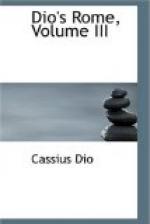[-50-] At Cyme in Campania, between Misenum and Puteoli, there is a crescent-shaped spot. It is shut in by small hills, bare except in a few places, and the sea there forms a kind of triple bay. The first is outside and near the cities; the second is separated from it by a small passage; and the third, like a real harbor, is seen far back. The last named is called Avernus, and the middle bay Lucrinus: the outer one belongs to the Tyrrhenian Sea and takes its name from that water. In this roadstead within the other two, which had but narrow entrances then, Agrippa, by cutting channels close along the shore through the land separating Lucrinus from the sea on each side, produced harbors affording most safe anchorage for ships. While the men were working a certain image situated above Avernus, either of Calypso to whom this place, whither they say Odysseus also sailed, is devoted, or to some other heroine, was covered with sweat like a human body. [-51-] Now what this imported I cannot say; but I will go on to tell of everything else worth reporting which I saw in that place. These mountains close to the inner bodies of water have springs full of both fire and water in considerable quantity mixed together. Neither of the two elements is anywhere to be found by itself (that is, neither pure fire or cold water alone is to be seen) but from their association the water is heated and the fire moistened. The former on its way down the foothills to the sea runs into reservoirs and the inhabitants conduct the steam from it through pipes into rooms set up high, where they use the steam for vapor baths. The higher it ascends from the earth and from the water, the dryer it becomes. Costly apparatus has been installed for turning both the fire and the vapor to practical use; and they are very well suited for employment in the conduct of daily life and also for effecting cures.
Now besides these products that mountain makes an earth, the peculiar nature of which I am going to describe. Since the fire has not the power of burning (for by its union with, the water all its blazing qualities are extinguished) but is still able to separate and melt the substances with which it comes in contact, it follows that the oily part of the earth is melted by it, whereas the hard and what I might call the bony part of it is left as it was. Hence the masses of earth necessarily become porous and when exposed to the dry air crumble into dust, but when they are placed in a swirl of water and sand grow into a solid piece; as much of them as is in the liquid hardens and petrifies. The reason for this is that the brittle element in them is disintegrated and broken up by the fire, which possesses, the same nature, but by the admixture of dampness is chilled, and so, being compressed all over, through and through, becomes indissoluble. Such is Baiae, where Agrippa as soon as he had constructed the entrances collected ships and rowers, of which he fortified the former with armor and trained the latter to row on wooden benches.




